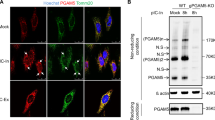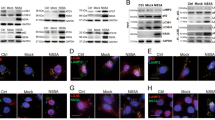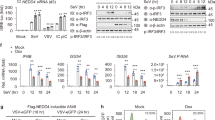Abstract
Mammalian autophagy-related 8 (Atg8) homologs consist of LC3 proteins and GABARAPs, all of which are known to be involved in canonical autophagy. In contrast, the roles of Atg8 homologs in noncanonical autophagic processes are not fully understood. Here we show a unique role of GABARAPs, in particular gamma-aminobutyric acid (GABA)-A-receptor-associated protein-like 2 (Gabarapl2; also known as Gate-16), in interferon-γ (IFN-γ)-mediated antimicrobial responses. Cells that lacked GABARAPs but not LC3 proteins and mice that lacked Gate-16 alone were defective in the IFN-γ-induced clearance of vacuolar pathogens such as Toxoplasma. Gate-16 but not LC3b specifically associated with the small GTPase ADP-ribosylation factor 1 (Arf1) to mediate uniform distribution of interferon-inducible GTPases. The lack of GABARAPs reduced Arf1 activation, which led to formation of interferon-inducible GTPase-containing aggregates and hampered recruitment of interferon-inducible GTPases to vacuolar pathogens. Thus, GABARAPs are uniquely required for antimicrobial host defense through cytosolic distribution of interferon-inducible GTPases.
This is a preview of subscription content, access via your institution
Access options
Access Nature and 54 other Nature Portfolio journals
Get Nature+, our best-value online-access subscription
$29.99 / 30 days
cancel any time
Subscribe to this journal
Receive 12 print issues and online access
$209.00 per year
only $17.42 per issue
Buy this article
- Purchase on Springer Link
- Instant access to full article PDF
Prices may be subject to local taxes which are calculated during checkout








Similar content being viewed by others
Accession codes
References
Ohsumi, Y. Historical landmarks of autophagy research. Cell Res. 24, 9–23 (2014).
Levine, B., Mizushima, N. & Virgin, H.W. Autophagy in immunity and inflammation. Nature 469, 323–335 (2011).
Deretic, V., Saitoh, T. & Akira, S. Autophagy in infection, inflammation and immunity. Nat. Rev. Immunol. 13, 722–737 (2013).
Tsukada, M. & Ohsumi, Y. Isolation and characterization of autophagy-defective mutants of Saccharomyces cerevisiae. FEBS Lett. 333, 169–174 (1993).
Slobodkin, M.R. & Elazar, Z. The Atg8 family: multifunctional ubiquitin-like key regulators of autophagy. Essays Biochem. 55, 51–64 (2013).
Wild, P., McEwan, D.G. & Dikic, I. The LC3 interactome at a glance. J. Cell Sci. 127, 3–9 (2014).
Mizushima, N., Yoshimori, T. & Levine, B. Methods in mammalian autophagy research. Cell 140, 313–326 (2010).
Weidberg, H. et al. LC3 and GATE-16 (GABARAP) subfamilies are both essential yet act differently in autophagosome biogenesis. EMBO J. 29, 1792–1802 (2010).
von Muhlinen, N. et al. LC3C, bound selectively by a noncanonical LIR motif in NDP52, is required for antibacterial autophagy. Mol. Cell 48, 329–342 (2012).
Nguyen, T.N. et al. Atg8 family LC3 and GABARAP proteins are crucial for autophagosome-lysosome fusion but not autophagosome formation during PINK1–Parkin mitophagy and starvation. J. Cell Biol. 215, 857–874 (2016).
Tsuboyama, K. et al. The ATG conjugation systems are important for degradation of the inner autophagosomal membrane. Science 354, 1036–1041 (2016).
Bestebroer, J., V'kovski, P., Mauthe, M. & Reggiori, F. Hidden behind autophagy: the unconventional roles of ATG proteins. Traffic 14, 1029–1041 (2013).
Sanjuan, M.A. et al. Toll-like receptor signaling in macrophages links the autophagy pathway to phagocytosis. Nature 450, 1253–1257 (2007).
Martinez, J. et al. Molecular characterization of LC3-associated phagocytosis reveals distinct roles for Rubicon, NOX2 and autophagy proteins. Nat. Cell Biol. 17, 893–906 (2015).
Martinez, J. et al. Noncanonical autophagy inhibits the autoinflammatory, lupus-like response to dying cells. Nature 533, 115–119 (2016).
Li, X., Prescott, M., Adler, B., Boyce, J.D. & Devenish, R.J. Beclin 1 is required for starvation-enhanced but not rapamycin-enhanced LC3-associated phagocytosis of Burkholderia pseudomallei in RAW 264.7 cells. Infect. Immun. 81, 271–277 (2013).
Chung, Y.H. et al. Microtubule-associated protein light chain 3 regulates Cdc42-dependent actin ring formation in osteoclast. Int. J. Biochem. Cell Biol. 44, 989–997 (2012).
DeSelm, C.J. et al. Autophagy proteins regulate the secretory component of osteoclastic bone resorption. Dev. Cell 21, 966–974 (2011).
Kumar, Y. & Valdivia, R.H. Leading a sheltered life: intracellular pathogens and maintenance of vacuolar compartments. Cell Host Microbe 5, 593–601 (2009).
MacMicking, J.D. Interferon-inducible effector mechanisms in cell-autonomous immunity. Nat. Rev. Immunol. 12, 367–382 (2012).
Meunier, E. & Broz, P. Interferon-inducible GTPases in cell autonomous and innate immunity. Cell. Microbiol. 18, 168–180 (2016).
Taylor, G.A., Feng, C.G. & Sher, A. p47 GTPases: regulators of immunity to intracellular pathogens. Nat. Rev. Immunol. 4, 100–109 (2004).
Boothroyd, J.C. Toxoplasma gondii: 25 years and 25 major advances for the field. Int. J. Parasitol. 39, 935–946 (2009).
Hunn, J.P., Feng, C.G., Sher, A. & Howard, J.C. The immunity-related GTPases in mammals: a fast-evolving cell-autonomous resistance system against intracellular pathogens. Mamm. Genome 22, 43–54 (2011).
Yamamoto, M. et al. A cluster of interferon-γ-inducible p65 GTPases plays a critical role in host defense against Toxoplasma gondii. Immunity 37, 302–313 (2012).
Selleck, E.M. et al. Guanylate-binding protein 1 (Gbp1) contributes to cell-autonomous immunity against Toxoplasma gondii. PLoS Pathog. 9, e1003320 (2013).
Martens, S. et al. Disruption of Toxoplasma gondii parasitophorous vacuoles by the mouse p47-resistance GTPases. PLoS Pathog. 1, e24 (2005).
Hara, T. et al. FIP200, a ULK-interacting protein, is required for autophagosome formation in mammalian cells. J. Cell Biol. 181, 497–510 (2008).
Ohshima, J. et al. Role of mouse and human autophagy proteins in IFN-γ-induced cell-autonomous responses against Toxoplasma gondii. J. Immunol. 192, 3328–3335 (2014).
Haldar, A.K., Piro, A.S., Pilla, D.M., Yamamoto, M. & Coers, J. The E2-like conjugation enzyme Atg3 promotes binding of IRG and Gbp proteins to Chlamydia- and Toxoplasma-containing vacuoles and host resistance. PLoS One 9, e86684 (2014).
Choi, J. et al. The parasitophorous vacuole membrane of Toxoplasma gondii is targeted for disruption by ubiquitin-like conjugation systems of autophagy. Immunity 40, 924–935 (2014).
Zhao, Z. et al. Autophagosome-independent essential function for the autophagy protein Atg5 in cellular immunity to intracellular pathogens. Cell Host Microbe 4, 458–469 (2008).
Park, S. et al. Targeting by autophagy proteins (TAG): targeting of IFNG-inducible GTPases to membranes by the LC3 conjugation system of autophagy. Autophagy 12, 1153–1167 (2016).
Lee, Y. et al. p62 plays a specific role in interferon-γ-induced presentation of a Toxoplasma vacuolar antigen. Cell Rep. 13, 223–233 (2015).
Selleck, E.M. et al. a noncanonical autophagy pathway restricts Toxoplasma gondii growth in a strain-specific manner in IFN-γ-activated human cells. MBio 6, e01157–15 (2015).
Meunier, E. et al. Caspase-11 activation requires lysis of pathogen-containing vacuoles by interferon-induced GTPases. Nature 509, 366–370 (2014).
Matsunaga, K. et al. Autophagy requires endoplasmic reticulum targeting of the PI3-kinase complex via Atg14L. J. Cell Biol. 190, 511–521 (2010).
Kirisako, T. et al. Formation process of autophagosome is traced with Apg8–Aut7p in yeast. J. Cell Biol. 147, 435–446 (1999).
Scherz-Shouval, R., Sagiv, Y., Shorer, H. & Elazar, Z. The COOH terminus of GATE-16, an intra-Golgi transport modulator, is cleaved by the human cysteine protease HsApg4A. J. Biol. Chem. 278, 14053–14058 (2003).
Kim, B.H. et al. A family of IFN-γ-inducible 65-kDa GTPases protects against bacterial infection. Science 332, 717–721 (2011).
Donaldson, J.G., Finazzi, D. & Klausner, R.D. Brefeldin A inhibits Golgi-membrane-catalyzed exchange of guanine nucleotide onto ARF protein. Nature 360, 350–352 (1992).
D'Souza-Schorey, C. & Chavrier, P. ARF proteins: roles in membrane traffic and beyond. Nat. Rev. Mol. Cell Biol. 7, 347–358 (2006).
Weidberg, H. et al. LC3 and GATE-16 N termini mediate membrane fusion processes required for autophagosome biogenesis. Dev. Cell 20, 444–454 (2011).
Paz, Y., Elazar, Z. & Fass, D. Structure of GATE-16, membrane transport modulator and mammalian ortholog of autophagocytosis factor Aut7p. J. Biol. Chem. 275, 25445–25450 (2000).
Fentress, S.J. et al. Phosphorylation of immunity-related GTPases by a Toxoplasma gondii–secreted kinase promotes macrophage survival and virulence. Cell Host Microbe 8, 484–495 (2010).
Serafini, T. et al. ADP-ribosylation factor is a subunit of the coat of Golgi-derived COP-coated vesicles: a novel role for a GTP-binding protein. Cell 67, 239–253 (1991).
Legesse-Miller, A., Sagiv, Y., Porat, A. & Elazar, Z. Isolation and characterization of a novel low-molecular-weight protein involved in intra-Golgi traffic. J. Biol. Chem. 273, 3105–3109 (1998).
Beck, R., Rawet, M., Wieland, F.T. & Cassel, D. The COPI system: molecular mechanisms and function. FEBS Lett. 583, 2701–2709 (2009).
Robben, P.M., LaRegina, M., Kuziel, W.A. & Sibley, L.D. Recruitment of Gr-1+ monocytes is essential for control of acute toxoplasmosis. J. Exp. Med. 201, 1761–1769 (2005).
Dunay, I.R., Fuchs, A. & Sibley, L.D. Inflammatory monocytes but not neutrophils are necessary to control infection with Toxoplasma gondii in mice. Infect. Immun. 78, 1564–1570 (2010).
Papic, N., Hunn, J.P., Pawlowski, N., Zerrahn, J. & Howard, J.C. Inactive and active states of the interferon-inducible resistance GTPase Irga6 in vivo. J. Biol. Chem. 283, 32143–32151 (2008).
Le Grand, J.N. et al. GABARAPL1 antibodies: target one protein, get one free!. Autophagy 7, 1302–1307 (2011).
Nakayama, K. & Takatsu, H. Analysis of Arf interaction with GGAs in vitro and in vivo. Methods Enzymol. 404, 367–377 (2005).
Zmasek, C.M. & Eddy, S.R. ATV: display and manipulation of annotated phylogenetic trees. Bioinformatics 17, 383–384 (2001).
Han, M.V. & Zmasek, C.M. phyloXML: XML for evolutionary biology and comparative genomics. BMC Bioinformatics 10, 356 (2009).
Katoh, K. & Standley, D.M. MAFFT multiplesequence alignment software version 7: improvements in performance and usability. Mol. Biol. Evol. 30, 772–780 (2013).
Söding, J., Biegert, A. & Lupas, A.N. The HHpred interactive server for protein homology detection and structure prediction. Nucleic Acids Res. 33, W244–W248 (2005).
Acknowledgements
We thank M. Enomoto (Osaka University) for secretarial and technical assistance, D. Soldati-Favre (University of Geneva), J.C. Howard (Instituto Gulbenkian de Ciência) and E.M. Frickel (Francis Crick Institute) for providing antibodies, M. Komatsu (Niigata University) for Atg7-deficient MEFs and H.W. Virgin (Washington University at St. Louis) for helpful discussion. Supported by the Research Program on Emerging and Re-emerging Infectious Diseases (grant no. 17fk0108120h0001) from the Agency for Medical Research and Development (AMED) (M.Y.), the Grant-in-Aid for Scientific Research on Innovative Areas (“Homeostatic regulation by various types of cell death”, grant no. 17H0557 (M.Y.), and “Matoryoshka-type evolution”, grant no. 26117713 (M.Y.)) from the Ministry of Education, Culture, Sports, Science and Technology of Japan (M.Y.), a Cooperative Research Grant of the Institute for Enzyme Research (M.Y.), the Joint Usage/Research Center of Tokushima University (M.Y.), the Takeda Science Foundation (M.Y.), the Ohyama Health Foundation (M.Y.), the Heiwa Nakajima Foundation (M.Y.), the Cell Science Research Foundation (M.Y.),the Research Foundation for Microbial Diseases of Osaka University (M.Y.) and the Naito Foundation (M.S.).
Author information
Authors and Affiliations
Contributions
M.S., N.S., H.B., Y.L., J.S.M. and M.Y. performed experiments; D.M.S. performed in silico analysis; M.S., S.N., T.K., T.Y., T.S., S.A., A.I. and M.Y. designed the experiments and analyzed the data; T.S. and S.A. provided critical materials; and M.S., A.I. and M.Y. wrote the manuscript.
Corresponding author
Ethics declarations
Competing interests
The authors declare no competing financial interests.
Integrated supplementary information
Supplementary Figure 1 Generation of mice or MEFs lacking mouse Atg8 family members or FIP200 by CRISPR-mediated genome editing.
(a) Unrooted phylogenic tree of murine Atg8 family members. (b, c, d, e, f, i) Schematic of the gRNA-targeting sites in the (b) Map1lc3a (LC3a), (c) Map1lc3b (LC3b), (d) Gabarap, (e) Gabarapl1, or (f) Gabarapl2 (Gate-16), (i) Rb1cc1 (FIP200) genes. Boxed and underlined regions are the gRNA target or PAM sequences, respectively. (g, j) Immunoblot analysis for the expression of indicated proteins and Actin in GABARAP TKO cells transfected with Flag-tagged empty or indicated vectors (g) or in wild-type and FIP200 KO MEFs (j). Data is one of the representative data in three independent experiments. (h) 293T cells were stimulated with 10 ng/ml hIFN-γ for 24 hrs. Lysates of unstimulated or stimulated cells were immunoprecipitated by indicated antibodies, and subjected to immunoblot to detect indicated proteins. Data was the representative of three independent experiments.
Supplementary Figure 2 Normal recruitment of interferon-inducible GTPases and effectors to T. gondii PCVs in MEFs lacking FIP200, Atg9a or Atg14.
(a) Immunostaining of T. gondii-infected IFN-γ-stimulated wild-type and indicated KO MEFs with antibodies against indicated antibodies (red), T. gondii (green), and DAPI (blue). Scale bars, 10 μm. Three independent experiments were performed. (b) Wild-type and indicated KO MEFs were treated with 10 ng/ml IFN-γ or not for 24 hours and infected with C. koseri (moi = 10) for 2 hours. The cells were fixed and stained with antibodies against indicated antibodies GBP1-5 (red), GBP2 (green), and DAPI (blue). Representative confocal microscope images of the recruitment of GBP1-5 or GBP2 on DAPI (indicative of bacteria) in WT or indicated KO MEFs. Scale bars, 10 μm. Images are from one of the representative data in three independent experiments. (Right) Results of quantification analysis for GBP1-5- or GBP2- and DAPI positive bacteria are shown. Indicated values were means ± s.d (three independent experiments per group). The “C. koseri” was not colocalized with DAPI. Although we easily detected DAPI staining of bacterial DNA inside of GABARAP TKO and Atg3 KO cells, we failed to detect such a pattern of DAPI staining at all in wild-type cells. Instead, WT cells contained corn-shaped accumulation of GBPs, which is very similar to the shape of C. koseri-containing vacuole and hardly detected in GABARAP TKO and Atg3 KO cells. Given the dramatic reduction of the C. koseri number after IFN-γ stimulated wild-type cells, we regarded the corn- shaped accumulation of GBPs as remnants of the bacteria. (c) Indicated MEFs treated with 10 ng/ml IFN-γ for 24 hr were infected with C. koseri (moi = 50) for 18-20 hours. Bacterial numbers are shown. Indicated values were absolute bacterial number ± s.d. of two independent experiments.
Supplementary Figure 3 HA-tagged Gate-16 is rarely localized on T. gondii PCVs.
(a) Immunostaining of IFN-γ-stimulated GABARAP TKO MEFs transfected with HA-tagged Gate-16 vectors with anti-GBP1 (green), anti-HA (red), anti- T. gondii (magenta) and DAPI (blue). Images are from one of the representative of three independent experiments. Indicated values were means ± s.d. (three biological replicates per group, in which almost 100 parasites were counted). ***P < 0.001 (two-tailed Student’s t-test). (b, c) Immunostaining of T. gondii-infected IFN-γ-stimulated wild GABARAP TKO MEFs (b) or Gate-16 KO MEFs (c) transfected with empty or indicated HA-tagged Gate-16 vectors with anti- T. gondii (green), indicated antibodies (red) and DAPI (blue). Images are from one of three independent experiments. Indicated values were means ± s.d. of three independent experiments, in which almost 150 parasites were counted. ***P < 0.001 (two-tailed Student’s t- test).
Supplementary Figure 4 GBP aggregation localizes to the Golgi or ER.
Immunostaining of IFN-γ-stimulated GABARAP TKO MEFs transfected with HA-tagged Gate-16(G116A) with indicated antibodies (green), anti-GBP1-5 (red) and DAPI (blue). Images are from a representative data in three independent experiments.
Supplementary Figure 5 In silico structural analysis of the Gate-16(25-LC3-29) mutant.
(a) Indicated values were means ± s.d. of GBP1 dot numbers per cell (Fig. 6i), in which three cells (Empty), three cells (Gate-16(WT)), or three cells (Gate-16(25-LC3-29)) calculated by ImageJ. **P < 0.01 (two-tailed Student’s t-test). Three independent experiments were performed. (b) Ribbon model of Gate-16 (WT) and Gate-16 (25-LC-29). Amino acids at residue 25-29 are shown as spheres. (c) Alignment of amino acids sequence of murine Atg8 family members around residue 25-29. Light blue and pink portions indicate the key five amino acids in GABARAPs and LC3s, respectively.
Supplementary Figure 6 Loss of acute resistance to Type III T. gondii infection in Gate-16-deficient mice.
(a) Wild-type (n = 9) or indicated KO mice (Gate-16 KO: n = 9 and IFNγR KO: n = 9) were infected with 1 ×104 CTG T. gondii, and the survival rates were monitored for 15 days. (b) Calculus equation of luciferase unit to parasite number. The luciferase units were measured at indicated parasite numbers, and used to generate a standard curve. (c) Prior to infection (upper) or at 4 d.p.i. (lower), spleens were collected and indicated surface markers of splenocytes from wild-type (left) or Gate-16 KO (right) mice were analysed by flow cytometry. Composition of CD19/CD3 and CD8/CD4 populations were reflected on each panel. Data was representative of three independent experiments. (d) Immunoblot analysis for the expression of indicated proteins and Actin in MLNs from wild-type and Gate-16 KO mice infected with T. gondii at 7 d.p.i. Data is one of the representative data in three independent experiments.
Supplementary Figure 7 Recruitment of inflammatory monocytes and neutrophils in control or LysM-Cre;Gate-16flox/flox mice infected with T. gondii.
(a) Peritoneal macrophages from indicated mice were stimulated with 100 ng/ml LPS for 24 hours. Indicated cytokine concentrations in the supernatants were determined by ELISA. Indicated values were means ± s.d. (three independent experiments per group). (b) LPS-induced upregulation of surface markers in peritoneal macrophages from indicated mice. The cells were stimulated with 100 ng/ml LPS for 24 hours. The indicated markers were tested by flow cytometory. Data were representative of three independent experiments. (c) Unstimulated or IFN-γ-stimulated wild-type and Gate-16 KO bone marrow-derived macrophages were infected with T. gondii (moi = 0.5) for 24 hours. Concentrations of NO2- or the indicated cytokines in the culture supernatants were measured by Griess method or ELISA, respectively. Indicated values were means ± s.e.m (two independent experiments per group). (d) Prior to infection (upper) or at 5 d.p.i. (lower), peritoneal cells were collected and indicated surface markers and YFP (T. gondii) of peritoneal cells from control (left) or LysM-Cre Gate-16fl/fl (right) mice were analysed by flow cytometry. Composition of CD11b/YFP, CD11b/Ly6C and CD11b/Ly6G populations were reflected on each panel. Data was representative of three independent experiments.
Supplementary information
Supplementary Text and Figures
Supplementary Figure 1–7 and Supplementary Table 1 (PDF 1449 kb)
Rights and permissions
About this article
Cite this article
Sasai, M., Sakaguchi, N., Ma, J. et al. Essential role for GABARAP autophagy proteins in interferon-inducible GTPase-mediated host defense. Nat Immunol 18, 899–910 (2017). https://doi.org/10.1038/ni.3767
Received:
Accepted:
Published:
Issue Date:
DOI: https://doi.org/10.1038/ni.3767
This article is cited by
-
Autophagy genes in biology and disease
Nature Reviews Genetics (2023)
-
Copper-induced Genotoxicity, Oxidative Stress, and Alteration in Transcriptional Level of Autophagy-associated Genes in Snakehead Fish Channa punctatus
Biological Trace Element Research (2023)
-
A new perspective on the autophagic and non-autophagic functions of the GABARAP protein family: a potential therapeutic target for human diseases
Molecular and Cellular Biochemistry (2023)
-
Unlocking the gate to GABARAPL2
Biologia Futura (2022)
-
Autophagy and microbial pathogenesis
Cell Death & Differentiation (2020)



